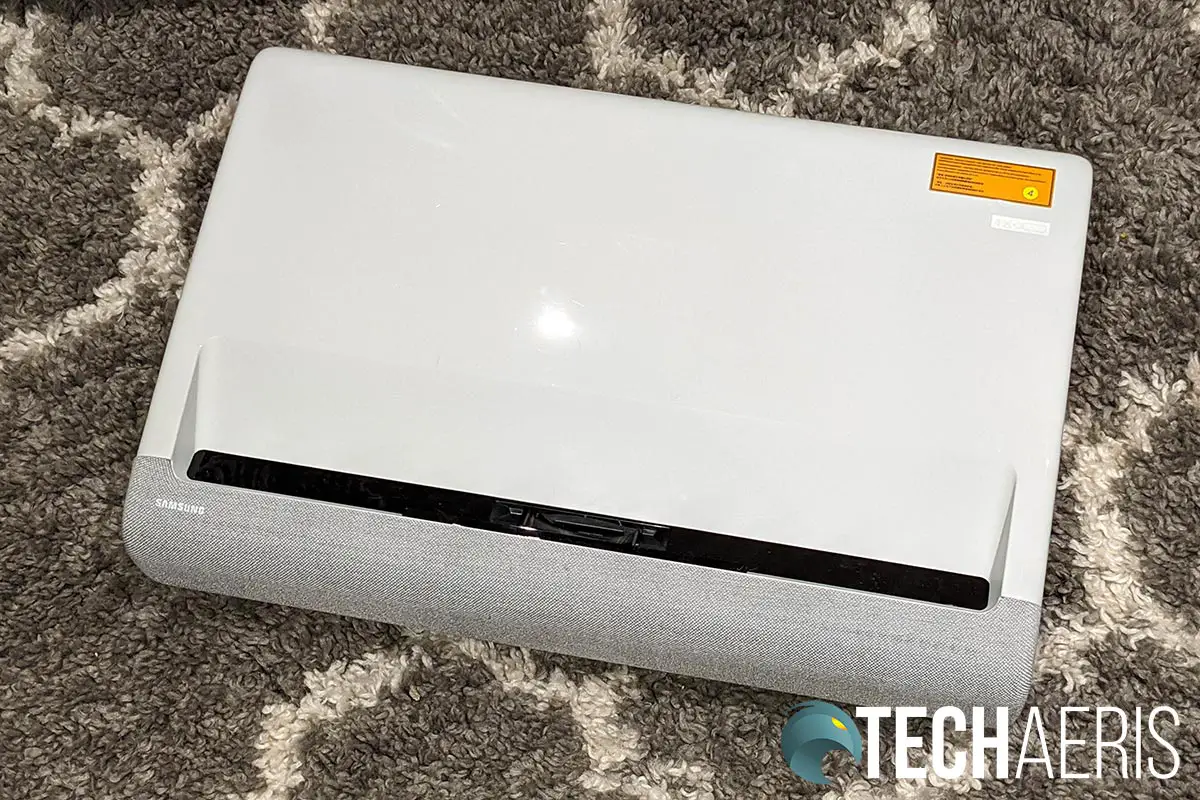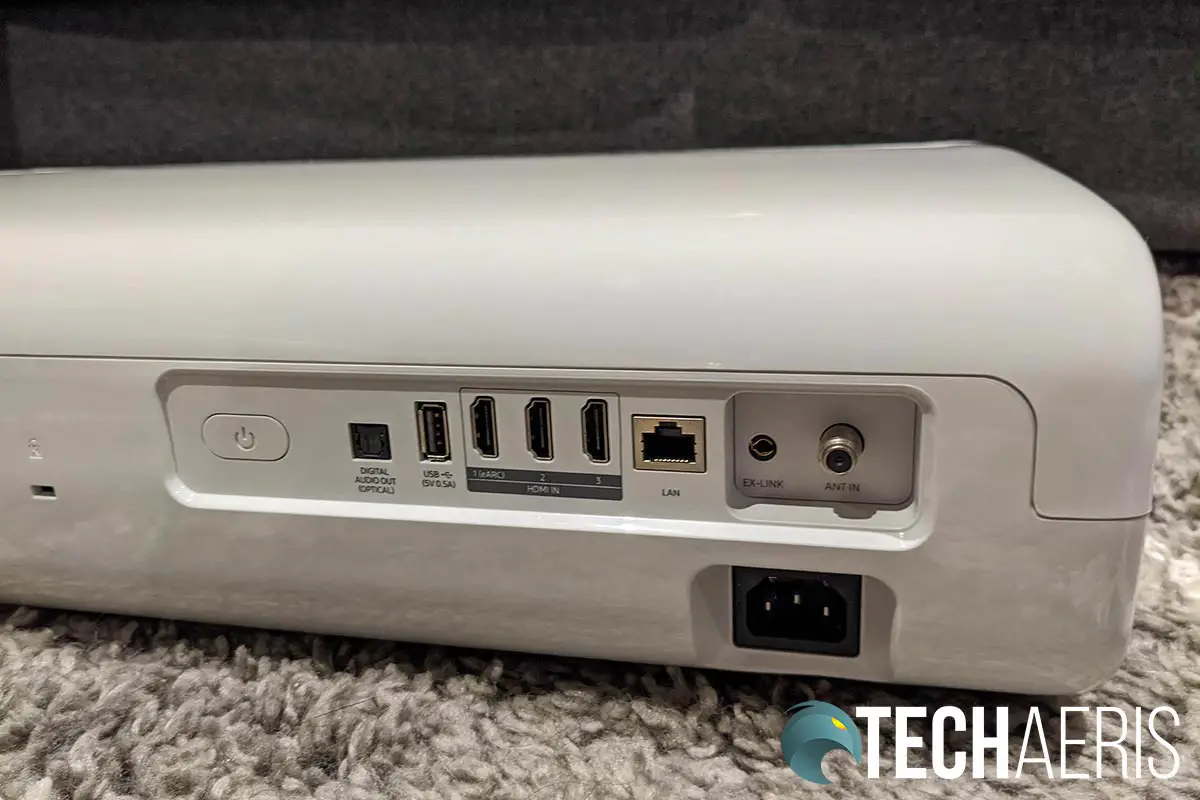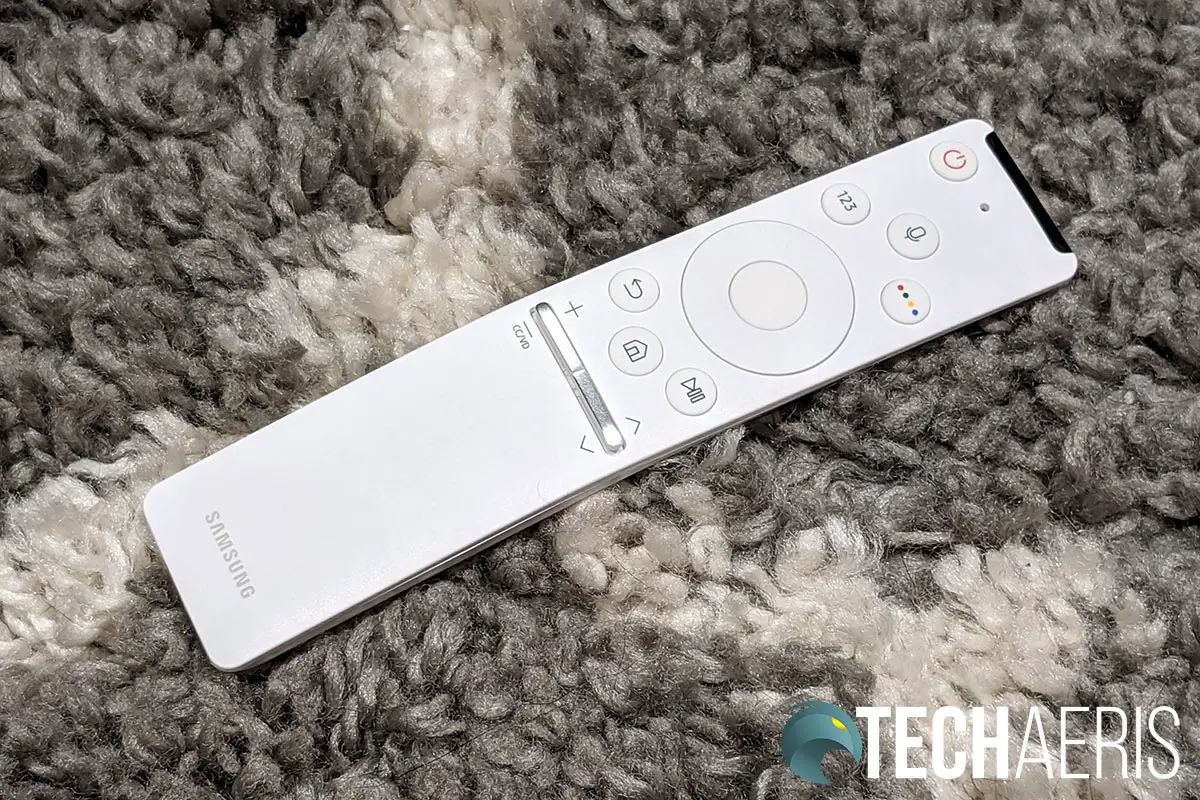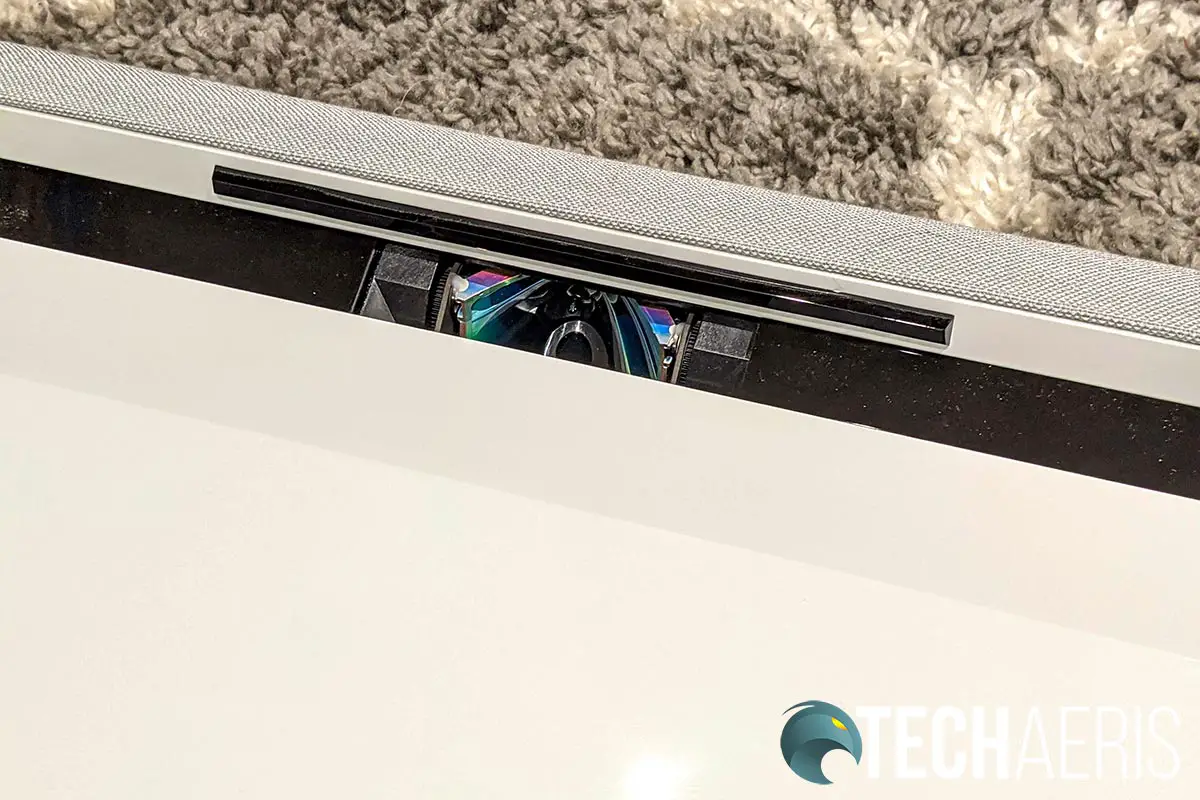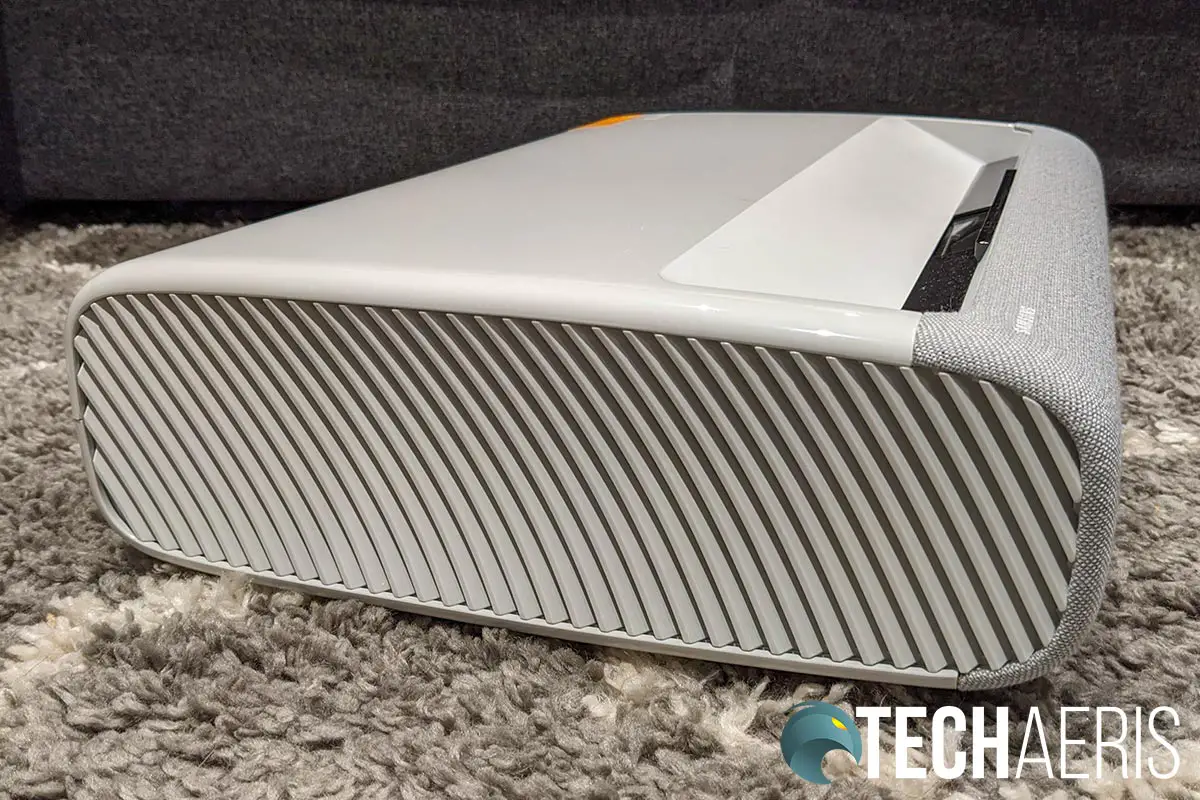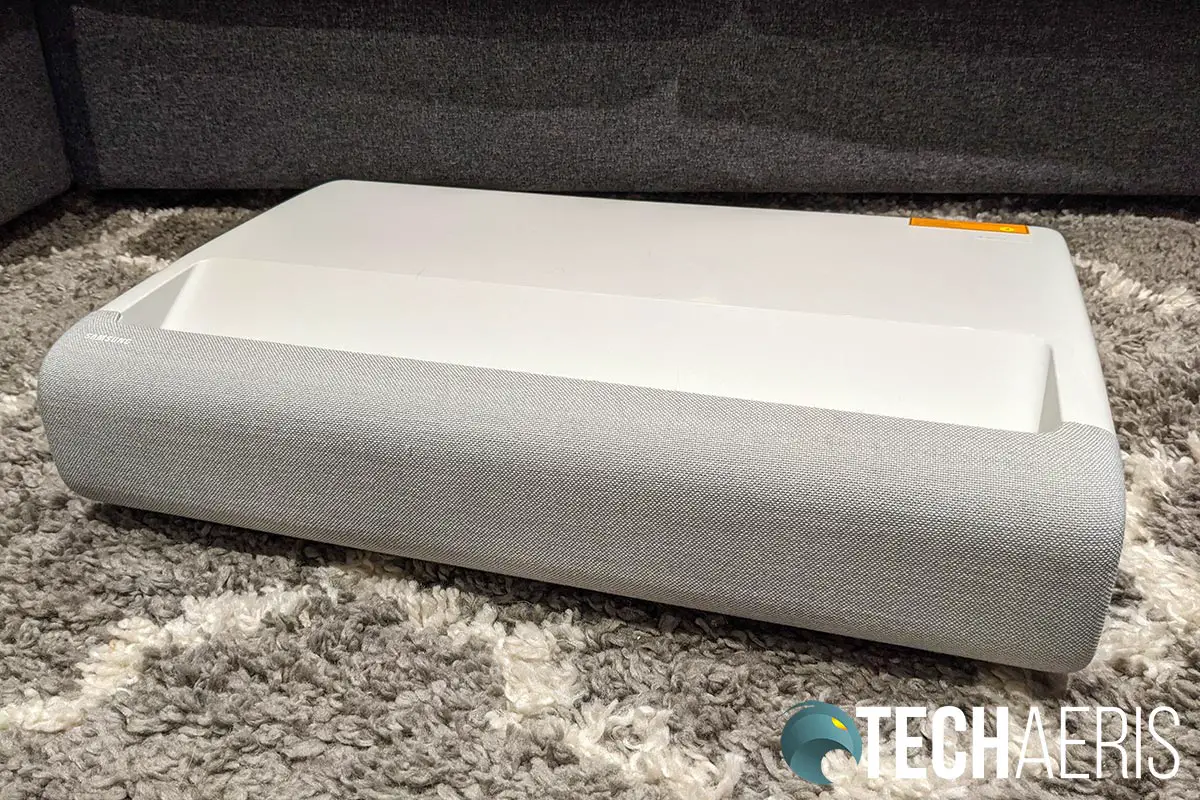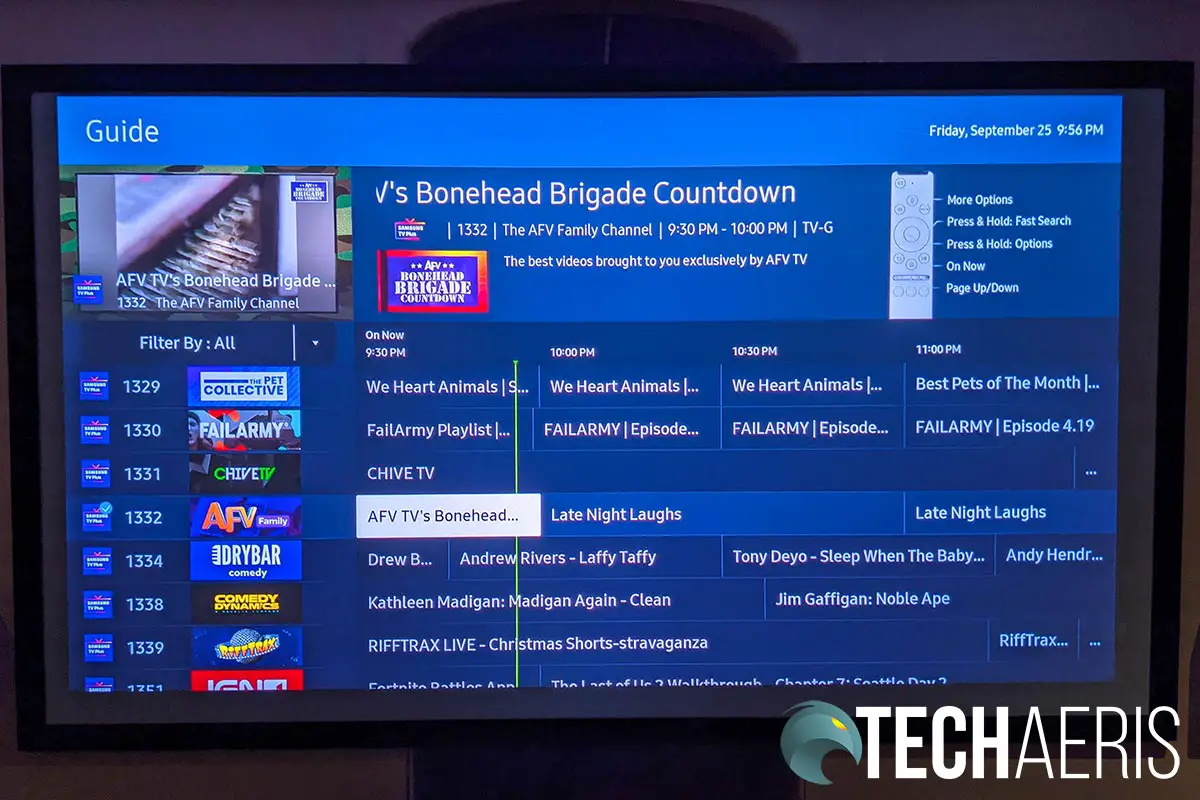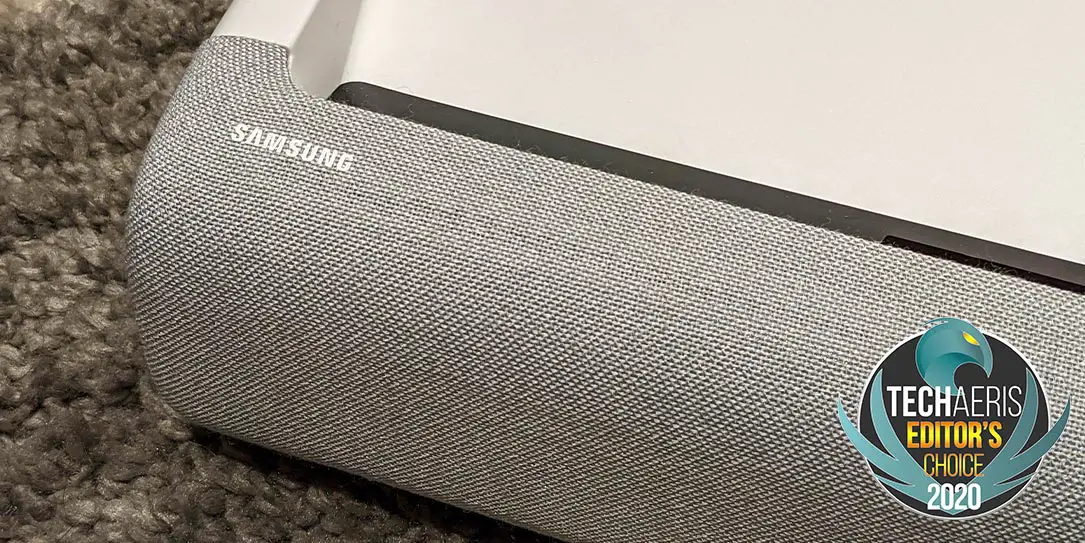
An industry leader, Samsung is well known for its panels and TVs, among other devices. After finding success with their 4K smart TVs, the company is branching out into smart projectors. Last month, they announced they are releasing two models of The Premiere: the LSP9T and LSP7T.
Estimated reading time: 21 minutes
Why now?
It’s been a while since Samsung released a projector so, like me, you might be wondering why now. Samsung made the move partially because more people are staying home to watch movies and, let us face it, movies do look better bigger. I have had a projector for over 10 years now and watching movies, TVs, and playing video games on a 106-inch screen are better than a smaller screen, hands down.
In addition, PMA, the Projector Market Outlook, expects rapid growth in the projector market. This is due to advancement of laser technology, growth of 4K/8K momentum, and the demand for ultra short throw projectors. As a result, given the PMA outlook, the fact more people are staying home to watch movies (also partly due to COVID-19), and bigger is better, it made sense for an industry giant like Samsung to take a stab at projectors.
Our Samsung Premiere LSP9T review looks at the larger of the company’s latest projectors that features 4K laser projection, HDR10/HDR10+/HLG support, a 40W speaker system, and a slew of smart TV features. Read on to find out what it easily earned a 2020 Editor’s Choice Award here at Techaeris.
Specifications
We are focusing on the LSP9T model as that is what we were sent to review. The LSP7T, while still capable enough, lacks a few of the features of the LSP9T. As such, we have included both in the specifications list below for comparison.
The Samsung Premiere projectors have the following features and specifications:
| LSP9T | LSP7T | |
| Projection System | Laser DLP | Laser DLP |
| Resolution (supported) | 3840×2160 | 3840×2160 |
| Brightness in ANSI Lumen | 2,800 | 2,200 |
| Contrast Ratio (Dynamic) | 2,000,000:1 | 2,000,000:1 |
| Contrast Ratio (Native) | 1,500:1 | 1,000:1 |
| Light Source | Triple laser (Red, Green, Blue) | Single Laser (Blue) |
| Light Source Life (hours) | 20,000 | 20,000 |
| Throw Ratio | 0.189 | 0.25 |
| Lens Shift | Not Available | Not Available |
| Keystone adjustment | 4pts (basic), 15pts (advanced) | 4pts (basic), 15pts (advanced) |
| Clear Image Size (Diagonal) | 100 inches | 100 inches |
| Image Size | 100 ~ 130 inches | 90 ~ 120 inches |
| Vertical Scan Rate | 60Hz | 60Hz |
| Picture Modes | Dynamic, Standard, Movie, FMM | Dynamic, Standard, Movie, FMM |
| Color Wheel Segment | No wheel used | 4 segments (R, G, B, Y) |
| BT.2020 Coverage | 106% | – |
| DCI-P3 Coverage | 147% | – |
| HDR Format | HDR10, HDR10+, HLG | HDR10, HDR10+decodable, HLG |
| Speakers | 40W 4.2 CH | 30W 2.2 CH |
| I/O Ports | 3x HDMI (1x eARC), 1x USB, LAN, Optical | 3x HDMI (1x eARC), 1x USB, LAN, Optical |
| Power Supply | 100-240V, 50/60Hz, 4.1A | 100-240V, 50/60Hz, 3.2A |
| Typical Power Consumption | 270W | 240W |
| Standby Power Consumption | Under 0.5W | Under 0.5W |
| Acoustic Noise | 32dB(A) (Bright mode) | 32dB(A) (Bright mode) |
| Dimensions (WxDxH) | 550x367x128mm | 532x342x117mm |
| Net Weight | 11.5Kg | 9.1Kg |
| Additional features | Mobile to TV Mirroring, Mobile Tap Mirroring, Remote Access, Easy Setup, App casting, Wireless/Wired TV On, Wi-Fi Direct, TV Sound to Mobile, Sound Mirroring | Mobile to TV Mirroring, Mobile Tap Mirroring, Remote Access, Easy Setup, App casting, Wireless/Wired TV On, Wi-Fi Direct, TV Sound to Mobile, Sound Mirroring |
What’s in the box
- Samsung Premiere LSP9T
- Remote control
- Power cable
- Batteries
- Manual
- Quick Setup Guide
Design
Samsung Premiere LSP9T
Like other laser projectors, the Samsung Premiere is larger than your typical DLP projectors. At the same time, however, it is 14% smaller overall than competing models from LG and Hisense. The projector is 21.65-inches wide, 14.45-inches deep, and just over 5-inches in height.
The first thing I noticed about the projector was the nice fabric finish on the front. The spotted greyish white finish covers the entire front and a part of the top of the projector. The Samsung logo is printed on the upper right just as the fabric wraps over the edge. As Samsung puts it, this gives it a “furniture-like” look and feel.
Just behind where the fabric finishes on the top front edge of the projector is where you will find the laser lens. This area does angle down and is sunken from the top of the projector. The laser area is encased in black. Each side of the projector has curved fins along the edges for air flow.
The back of the projector is where you will find the necessary ports. On the far left (when looking at the back), about 1/3 of the way in, there is another vent. The port array is towards the right hand side on the upper half of the back. Starting from the middle towards the right edge of the projector is a power button, optical audio out, USB, three HDMI IN (one eARC), an Ethernet cable port, EX-LINK, and a coax ANT IN for connecting to a cable box. On the right hand side below this is your standard power plug.
The bottom of the projector has two adjustable feet near the front and a wider, non-adjustable foot near the back. There are also four mounting holes should you want to mount your unit from the ceiling. It is heavy though at 25.35lbs (11.5kg) so you will want to secure it well if ceiling mounting it.
Whether it is sitting on an entertainment unit or mounted above, the Samsung Premiere really blends in and looks good sitting on your entertainment unit.
Remote
At first glance, the included remote is really underwhelming. It is white and small (6 by 1½ by ¾-inches). There are a total of seven buttons, a circle navigation wheel, and two thumb toggle bars for volume and channel changing. The buttons allow you to power on the system, enable voice commands, return to previous menu/go back, access the home menu, play or pause the current media, and navigate through the various menus. Simple is good at the end of the day and the remote was more than adequate to complete any task on the system.
Setup
Electronics can be daunting to set up at times. With the Samsung Premiere, it is easy. The part that takes the longest is finding the right position to set it up for the picture size you want. As this is an ultra short throw projector you will be setting it up close to your screen.
Physical setup
In my case, to get a 100-inch picture the back edge of the Premiere is a mere 4.4-inches from the screen and the base of the projector is 13.8-inches from the bottom of it. I could go a bit bigger, but I would have to adjust a few things with my wall-mounted screen and my entertainment system on where the projector was sitting. Of course, if I were buying this (which I wish I could), I would take the time to properly set up. The LSP9TFA projects a maximum image size of 130-inches and at this size, the back edge of the projector sits a mere 9.4-inches from the wall and the front about 23½-inches from the wall. It sure beats the 12 or so feet my ceiling mounted projector sits from the wall.
Next, plug it into a power outlet and you really are good to go. Before I did turn it on, however, I plugged my Xbox One into a non-eARC HDMI port and the same with our Nintendo Switch. The reason for plugging them into non-eARC ports is because I did not want them turning on each time I turned on the projector. I did later test the Xbox One with the eARC port and it worked as intended. At any rate, once everything was connected, I turned on the projector using the included remote control.
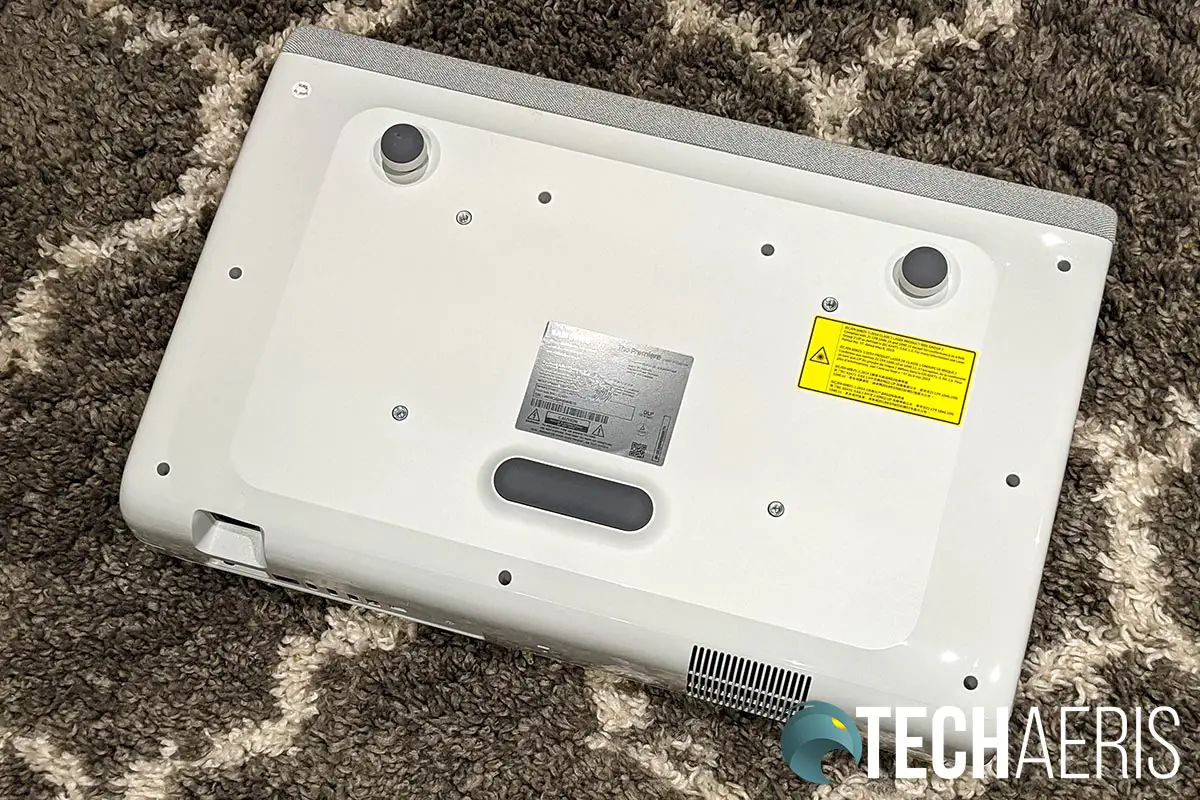
Software setup
The first screen you will see is a welcome screen with a picture of the remote. Even though the remote powers the system on out of the box, you will have to pair it to the projector before continuing. To do so, you will need to hold the back and play/pause button for 5 to 10 seconds. Once paired, you will see an animation on the screen that pairing was successful. Once paired, you select your language, then click next. On the next screen, accept the Terms & Conditions after which you can select your location so Samsung can provide you with localized content.
Throughout the rest of the process, you will be prompted to set up a network (if not plugged in via an Ethernet cable), select a voice assistant (Bixby, Amazon Alexa. or Google Assistant), and verify your connected devices. In my case, both the Xbox One and Nintendo Switch were detected on their respective ports and the appropriate shortcut icons were added to the home screen for quick access.
All told, it took about half an hour from placement to being able to fully enjoy the projector.
Display
Typical laser projectors feature a single laser and a colour wheel. The Samsung Premiere LSP9T gets rid of the colour wheel and has three separate RGB lasers. Not only does this provide better colour but also increases the brightness of the picture output. The LSP7T still has a colour wheel but adds a yellow component to it on top of the RGB.
For the more technical readers out there, the LSP9T uses a 0.66” DMD DLP chip. Presumably, this is Texas Instruments’ 0.66″ DMD chip, which you can read more about on their website.
There is no question the display output from the LSP9T is the best I have seen to date from a 4K projector. There was no need to mess around with focus as the projector was perfectly focused out of the box. Should you need to, you can adjust it using the motorized focus adjustment in the projector settings menu. In fact, with some content, it almost feels too crisp and clear. At first, it was a bit jarring as sometimes things seemed too real. After some time adjusting to the clarity, it made watching TV shows, movies, and playing games that much more enjoyable.
A peak brightness of 2800 lumens and being so close to the screen makes for a bright picture, regardless of the scene. With HDR10+ (the first 4K laser projector to be certified) and HLG support alongside 106% BT.2020, BT.709, and 147% DCI-P3 coverage, the colour representation is outstanding. I also found the 2,000,000:1 dynamic contrast produced some of the blackest blacks I have ever seen in a projector. Content that I have already experienced, including movies like Avatar and various Xbox games, looked even better than before and were that much more enjoyable to watch and play. Samsung’s Motion Estimation & Motion Compensation (MEMC) found on their TVs is included with the projector. This makes high action scenes and sports even smoother.
Display settings
While I stuck with the default settings given the excellent out-of-box quality, there are plenty of settings that you can access and change to get the picture exactly right for you. When set to Auto, the projector will automatically switch to match the input colour mode if it can. Adjustable display settings include:
- Picture Mode: Dynamic, Standard, Movie, Filmmaker Mode
- Picture Size: including fit to screen, zoom, and position
- Expert Settings: Contrast, Sharpness, Color, Tint (G/R), Apply Picture Settings, Picture Clarity Settings, Contrast Enhancer, Film Mode, Color Tone (Cool/Standard), White Balance, Gamma, Shadow Detail, RGB Only Mode, Color Space Settings (Auto, Native, Normal, Custom (BT.2020, DCI-P3, BT.709)), Reset Picture
For the purists, the Samsung Premiere LSP9T also includes Filmmaker Mode (FMM). This is a new mode suggested by the UHD Alliance. FMM preserves the intended aspect ratios, colours, and frame rates for a more cinematic experience. While I prefer the other display setting and more vivid colour, FMM on the projector does offer a more cinema-like experience. It does this by disabling motion smoothing, noise reduction, sharpening, and other image enhancements. If this is something that really interests you, the Premiere is the world’s first projector to support FMM.
Screen adjustment (keystone)
While software related, it is also display related, so I will include it in this section. Typically speaking, the keystone correction on projectors displays a trapezoid that you then adjust until it is as close to a rectangle as you can get. The Samsung Premiere has a 4- or 15-point keystone screen adjustment feature. With the four point, you are shown a grid with four points near (but not at) each corner. Selecting one of these and moving it up, down, left, or right will adjust the corresponding corner. While this is usually enough, in my case I found the 15-point adjustment more useful. When selected, another 11 points are added including 3 on the top and bottom edge, one on the left and right edges, and 3 in the middle. This gives you much more control over adjusting your image and is easy to use.
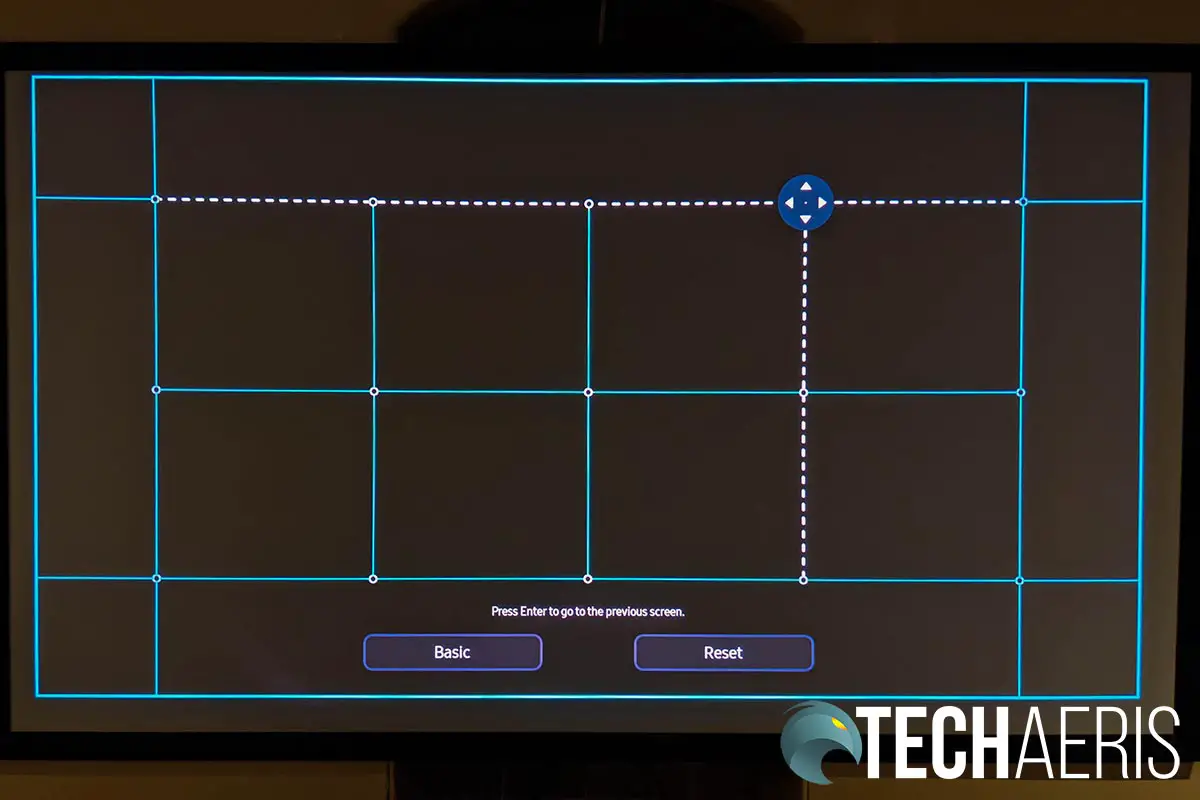
Software/Ease of Use
I have reviewed a couple smart projectors in the past and there always seems to be something lacking when it comes to the software. These shortcomings range from being underwhelming in features to being difficult to figure out and use to not exactly working as intended. Outside of Android TV (which is not perfect by any means), I’ve yet to find a smart projector interface that felt intuitive and just worked without climbing through a bunch of hoops.
With the Samsung Premiere, I must admit that I was extremely impressed. I have never used a Samsung TV before, so I have not had any experience with their Smart TV interface. It just worked once I was past the initial set up. In fact, I could write up an entire review on the interface but will try and keep it short here.
Main interface
The main interface has a row of tiles along the bottom for easy access to your apps and devices. Moving to the left will show icons for home, apps, search, and settings. Scrolling over each of these will pop up a sub menu just above the main icons. For example, moving over home will display shortcuts for your profile, notification settings, and privacy settings. Settings, on the other hand, gives you access to quick settings like the e-Manual, picture mode, sound mode, sound output, game mode, caption toggling, and sleep timer settings.
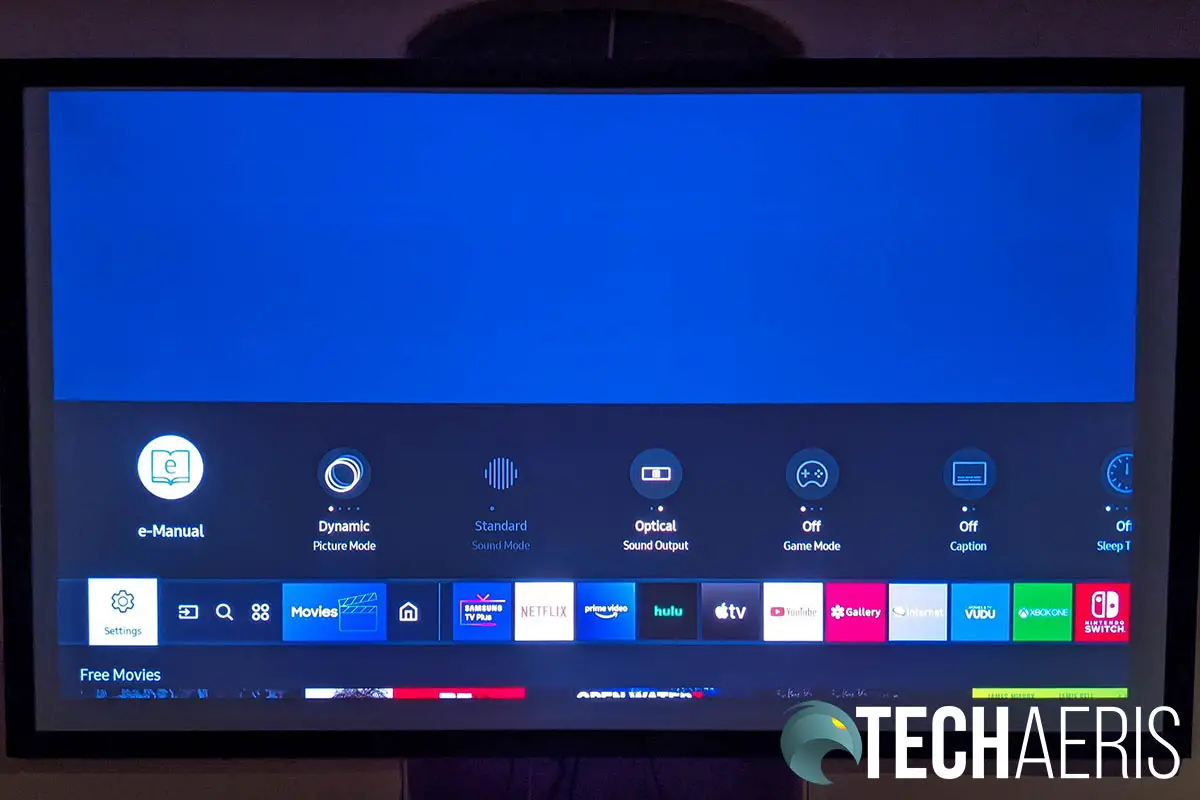
You can also click on each of these and a full menu will open. In the case of the settings menu, this gives you access to pretty much everything you need to fine tune the projector. You can change picture mode, picture size, and other display settings (as mentioned above), sound settings, broadcast settings if connected to a cable box, general settings like voice, network, external device management, and update the software on the projector.
In addition to the Xbox One and Nintendo Switch tiles, the Premiere also offers users quick access to Samsung TV Plus with free news, sports, movies, and TV channels, Netflix, Prime Video, Hulu, Apple TV, YouTube, Gallery, Internet, and VUDU. And it does not stop there as you can install other apps like Disney+, Spotify, games, and much, much more. When scrolling over a tile, it gives you a preview of some of the content you can view. For example, with Netflix, a secondary bar slides in above the main tiles and you can change your profile, continue watching what you were last time you were in Netflix, as well as scroll through some suggested offerings. In other words, you do not have to launch Netflix and go through the usual steps to continue where you left off — you just click the last watched tile and you are all set.
Voice assistant
You can also control the projector using Bixby, Amazon Alexa, or the SmartThings app. With Bixby, you can control the projector and connected devices, search for TV shows, movies, and other information, and manage your projector and other connected devices. Alexa is a bit more limited and lets you stream music, get information like the weather, and control your smart home devices including basic features on the projector. The SmartThings app allows you to control your projector from your smartphone.
Other device connections
If you have a Samsung smartphone (I do not) and SmartThings installed, you can also tap the back of the phone against the right side or top of the projector to project your smartphone screen on the projector. Apple AirPlay support is also included so Apple users can play videos, music, photos, and more directly from their Apple devices. Finally, the Remote PC feature lets you wireless connect to a Windows or Mac computer and use your PC applications, browse the web, or even play your PC games on the projector.
Overall, the interface was extremely easy to navigate and use, and everything was where I expected to find it once I started poking around.
Performance
Projectors typically take some time to warm up. With the Samsung Premiere LSP9T (and other laser projectors), it turns on quickly and powers off just as quick. From pressing the power button, it takes mere seconds before the picture is projected on the screen. Navigation is straightforward and response, and everything really is simple to use. During operation, the projector is quiet as well. At its brightest mode, the acoustic noise is only 32dB. In addition, because you are not sitting under the projector as in a typical setup, it seems even quieter.
Gaming Mode
Based on my set up, accessing the Xbox icon turns on the Xbox One at the same time. You can even navigate through your main Xbox screens with the included Samsung remote which, even though a small thing, did put a smile on my face. It allowed me to use things like Plex or perform storage maintenance or check for updates on my Xbox without needing to fire up my controller. On that note, the Samsung Premiere also has a Game Mode which reduces the input lag for gaming. By default, the input lag on the projector is 87ms, with Game Mode it drops down to 53ms. Sure, that still seems like a lot for hardcore gaming but during my gaming sessions (which included FPS, racing games, adventure games, and more) I did not notice lag all that much, if at all.
Eye Protection Mode
One final note, even though it is an ultra short throw projector, lasers can be damaging to your eyes if they are accidentally exposed. Samsung has incorporated an Eye Protection Mode that dims the projected light if it detects someone or something close to it. You do have to be close to it and I did notice it kicking in when I was leaning over the top of the projector to check an input or something behind it. While it can be disabled, there is no reason you should not leave it on for safety.
Sound Quality
The Samsung Premiere LSP9T has a 4.2 channel 40W speaker system hidden underneath the front fabric covering. Combined, the sound system quite crisp and clear — not to mention very loud. All told, there are two 5W tweeters, two 10W woofers, and an acoustic beam (LSP9T model only) consisting of two more 5W components. Altogether, this makes up for the 40W speaker output.
A volume of around 20 was more than adequate in my basement and easily filled the room. While it can go louder, it does start to distort at around 65-70 volume but at that point you are covering your ears anyway. Samsung is using patented Samsung Acoustic Beam technology found in their soundbars. As such, the acoustic beam on the Premiere has a total of 22 tuned ports on each side, each getting larger the further away they are from the center. With this design, the sound signal gets distributed evenly due to the distance it must travel. When I first really started watching content on the projector, I could hear some of the sound coming from the sides of the room as it bounced off my walls. Depending on content, this was more pronounced for movies and while gaming.
The speaker system is quite loud and clear, but there is not overly much in the way of bass. Being a projector, however, I can see why. Too much and I suspect you risk the projector shaking, hence causing the image to jitter on the screen. There was subtle enough bass to get a feel for things, but you will be missing the rumble that a proper subwoofer in a home theatre system provides.
After testing out the internal speakers, which are decent enough, I connected the optical output to my receiver, allowing me to get my usual 5.1 surround speaker sound for the Xbox One, Switch, and content I watched via the Smart TV interface. You can also connect wireless speakers to the projector and use that as your audio out as well if you so choose.
Price/Value
With an MSRP of US$6,499.99, the Samsung Premiere LSP9T laser projector isn’t exactly cheap. But then again, laser projectors typically aren’t. On that note, it is pretty comparably priced to its main competitors. However, it is also the first to be HDR10+ certified, can project up to 130″ screen size, and has pretty decent sounding speakers on board with a surround sound like experience. Not to mention a robust smart TV interface that just simply works.
It is tough to justify such an expensive purchase but if I had the cash handy, I’d have no problem tossing it down for one of these and being totally happy about my purchase for years to come. But hey, if you’re on the fence, Samsung does offer 0% financing for up to 48 months.
Wrap-up
Laser projectors by default are typically better than their non-laser counterparts and the Samsung Premiere steps that up a notch by eliminating the colour wheel altogether on the LSP9T version of the projector. If you want some of the best colour and display quality you can get, this projector easily meets those criteria. While it’s been a few years since Samsung released a projector, they have years of TV experience to pull from and have hit a home run here. Not only that, some of the features and technology that make Samsung TVs great has been integrated into the projector as well, offering a stellar and robust experience.
Not only does it have an excellent display, but the onboard soundbar is also decent enough, and there are plenty of apps and functionality included. There is no question it is deserving of a 2020 Editor’s Choice Award here at Techaeris.
In some of our articles and especially in our reviews, you will find Amazon or other affiliate links. As Amazon Associates, we earn from qualifying purchases. Any other purchases you make through these links often result in a small amount being earned for the site and/or our writers. Techaeris often covers brand press releases. Doing this does not constitute an endorsement of any product or service by Techaeris. We provide the press release information for our audience to be informed and make their own decision on a purchase or not. Only our reviews are an endorsement or lack thereof. For more information, you can read our full disclaimer.
Last Updated on December 27, 2022.

